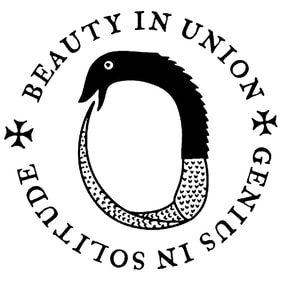
The ouroboros featured in our device is a dragon derived from a old Greek alchemical manuscript on gold-making attributed to Cleopatra [shown above]. The original glyph circled a Greek phrase ‘ἕν τὸ πᾶν‘ or ‘All in All‘ intended as a reference to the One Matter from which the Philosopher’s Stone is composed. The serpent biting its tail is also a cosmological symbol of cycles and eternity and a hieroglyph of the alchemical formula Solve et Coagula. It shares in a singular dualism just as the alchemical REBIS, or two-thing found in the emblematic references related to the Chymical Wedding. It is in reference to this conjunctio that is expressed in the first half of the motto; 'Beauty in Union' (wherein the serpent bites its own tail) as well as the Unity expressed by such a marriage, the second half of the motto, 'Genius in Solitude,' expresses the nature of the Adept who has become one with the Stone of the Wise. One of the things that alchemy shares with the old printers device is that often the motto would contain a riddle actually called a ‘rebis’ which was a word puzzle. The motto; 'Beauty in Union' and 'Genius in Solitude' shares in this tradition not only with the alchemical references just mentioned but also with a nod to Hermetic Qabalah. Essentially ‘beauty’ and ‘union’ are attributes of Tiphareth, whereas ‘genius’ and ‘solitude’ can be applied to Kether. In occult anatomy those two sephirah correspond to the head and the heart and also signify the union between the microcosm and the macrocosm.
ABOVE IMAGE: Fragment from a manuscript copy of Chrysopoeia of Cleopatra. A letterpress print of this important manuscript may be purchased HERE.
ABOVE IMAGE: Fragment from a manuscript copy of Chrysopoeia of Cleopatra. A letterpress print of this important manuscript may be purchased HERE.